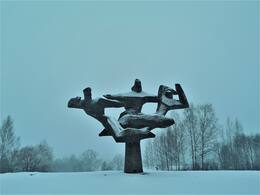Apie Raudonosios armijos karių nusikaltimus Tukume.
Sovietų okupacijos metais Tukume buvo pastatyti keli paminklai Raudonajai armijai. Šiandien jie neprarado savo buvusių sovietinių ideologinių tikslų ir toliau kuria mitą apie Raudonąją armiją kaip išvaduotojus. Apie Raudonosios armijos karių nusikaltimus yra išlikę įvairių šaltinių. Vieną šaltinių grupę galima rasti vietiniuose laikraščiuose, kuriuose vaizdingai aprašomas Raudonosios armijos nusikaltimų leistinumas ir mastas.
(..) Tukume raudonarmiečiai nužudė kelis gyventojus [...] Šiomis dienomis ir vėliau raudonarmiečiai masiškai prievartavo moteris. Smurto veiksmai buvo daromi net prieš 12-14 metų mergaites [..] Raudonarmiečiai gatvėje praeivių prašė laiko, o kai pasakė, paėmė laikrodį. Iš daugelio žmonių pavogti vestuviniai žiedai, paimti dviračiai. Dažnai pasitaikydavo, kad raudonarmietis, įėjęs į namą, šovė į orą, o paskui visiškai apiplėšė įbaugintus gyventojus. (...).
(..) vargu ar tukmiškių namai liko neaplankyti raudonarmiečių. Laikrodžiai, vertybės, degtinė, uogienė, medus – buvo pagrindinės vertybės, kurių buvo ieškoma [...] Raudonoji armija sulaikė apie. 30-metę moterį ir paklausė: „Sulaužyti dantys! Adresatė atvėrė burną, kurioje buvo keli auksiniai dantys. Mongolė, daug negalvodama, čia pat gatvėje ištraukė nelaimingajai moteriai iš burnos dantis ir išėjo (..)“
Laikraštis „Tukuma zina“. Praėjo. 1944 metų rugpjūčio 29 d.
Susijusi laiko juosta
Susijusios temos
Susijusios vietos
Monument for the Freedom-Fighters
It is located in Tukuma, Mālkalna, Jelgavas street 15A.
The monument was opened in 1975 to highlight the merits of the Red Army during World War II. It served as a means of Soviet ideology and propaganda, symbolically strengthening the presence of the occupation regime in Latvia and creating the myth of the Soviet power as "liberators". The author of the monument is sculptor and resident of Tukums Arta Dumpe.
After the capitulation of Germany on May 8, 1945, the Red Army perceived Kurzemi as a territory conquered from the enemy and not a liberated part of the USSR. The inhabitants of Kurzeme were enemies and their property was considered war trophies. The repressive authorities and the army began the "Cleaning of Kurzeme". Men aged 16-60 were detained, registered and examined. In terms of danger, the inhabitants of Kurzeme - men - were compared to the military personnel of capitulated Germany. The permissiveness of the Red Army and the wave of crimes began - murders, rapes, robberies, arrests and "disappearances of people". The only armed resistance was from the National Guerrilla groups. The Soviet authorities created fighter battalions, including in the Tukum district, to eliminate any counter-action. The wave of violence and terror reached its climax in 1949, when the population was deported throughout Latvia.
Today you can see the monument. Its symbolic meaning is explained in different ways - a battle scene or a mother holding her sons fighting on opposite sides. The monument is installed on a hill with an impressive view.





